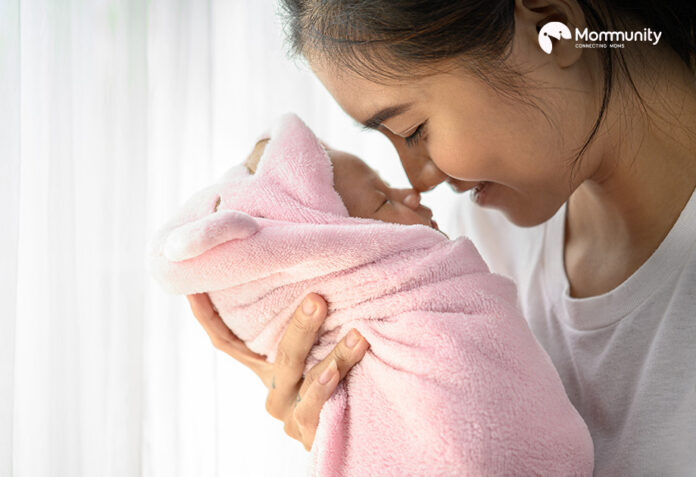Have you ever thought about your baby’s first sense? Are you curious about knowing what is the first sense a baby develops? The entry of an infant could be a miracle of nature. This modest human, new from the womb, sets out on a surprising journey of tangible investigation. But which sense comes online to begin with, permitting them to encounter the world around them? Buckle up since the reply might astonish you!
The reply might surprise you. It’s not sight, with its dazzling colors and complicated points of interest. It’s not hearing, with its orchestra of sounds and voices. The exceptionally to begin with sense to create in an infant is touch.
Touch starts its advancement surprisingly early, around 8 weeks into pregnancy. Little receptors begin shaping on the face, especially around the lips and nose. These are the pioneers, the primary pilgrims of the baby’s world inside the womb. As weeks advance, these receptors spread all through the body, coming to the palms and soles by 12 weeks and the guts by 17 weeks.
By the center of the third trimester, the infant can be involved in an entire run of sensations, counting warm, cold, weight, and indeed torment (even though the neural pathways for handling torment completely create afterward).
Why is touch so crucial?
Touch is more than a sense; it’s a crucial requirement. It plays a crucial part in a baby’s advancement, both physically and candidly. Skin-to-skin contact with a caregiver is basic for directing a baby’s body temperature, heart rate, and breathing. It moreover triggers the discharge of oxytocin, a hormone that advances holding and sentiments of cherish and security.
Envision a world without touch. An infant wouldn’t be able to feel the comforting warmth of their mother’s grasp or the tender caress that eases them to rest. They wouldn’t be able to investigate their claim bodies or the interesting surfaces of the world around them. Touch is the establishment upon which all other faculties construct. It gives a sense of security and cultivates a sense of self and the world around them.
The Symphony of Senses: A Gradual Awakening
Whereas touch takes the lead part within the early stages, other faculties are not far behind. Here’s a see at the formative timeline of a baby’s tactile arousing:
Hearing
Hearing begins developing around 16 weeks in the womb. The child can listen to suppressed sounds from the exterior world, counting their mother’s voice and pulse. Considers propose they can indeed recognize and recognize voice designs.
Taste and Smell
These two faculties are closely connected and created around the same time, starting around 8 weeks. Taste buds start to create on the tongue, and the mindful scent begins taking shape. Newborns have a solid sense of scent and can indeed recognize their mother’s fragrance in no time after birth. They moreover appear an inclination for sweet tastes, a survival instrument that makes a difference in them promptly acknowledging breast drain.
Sight
Sight is the final of the major faculties to create completely. At birth, a baby’s vision is foggy and ungraceful. They can, as it were, see objects inside a near run, almost 8 to 10 inches, which is generally the distance their caregivers confront when supported. Be that as it may, their vision creates quickly over the first few months, and by 3 months, they can see objects at a more noteworthy remove and start to track moving objects.
A Multisensory Experience: The Interconnected World of a Baby
It’s important to keep in mind that these faculties do not create segregation. They work together to make a wealthy and interconnected tactile encounter for the child. For illustration, an infant might smell their mother’s recognizable fragrance (smell), feel the warmth of her touch, and listen to the relieving sound of her voice (hearing) all working together to create a feeling of consolation and security.
The Power of Sensory Play: Nurturing Your Baby’s Development
Understanding the advancement of a baby’s faculties can offer assistance to guardians and caregivers to create a fortifying environment that cultivates sound development. Here are a few tips for consolidating tactile play into your baby’s schedule:
Touch
Give a bounty of skin-to-skin contact through snuggling, delicate rub, and holding. Offer toys with distinctive surfaces for them to investigate.
Hearing
Conversation and sing to your infant in alleviating tones. Uncover them to diverse sounds and music. Musical exercises like shaking and influencing can be calming.
Taste and Smell
Whereas newborns essentially depend on breast drain or equation, you’ll present them to diverse tastes and smells as they begin investigating strong nourishments. Keep in mind to present modern nourishments one at a time and screen for any unfavorably susceptible responses.
Sight
Give outwardly fortifying toys with striking colors and tall differentiated designs. Hang mobiles over their bunk or playpen.
In the end, we hope you get the answer: what is the first sense a baby develops? A baby’s journey of disclosure begins shockingly early, with the sense of touch taking the lead part. Indeed, within the womb, they start to investigate the world through touch. This foundational sense plays a crucial part in a baby’s advancement, cultivating enthusiastic well-being and giving a bridge to the other faculties that stir afterward.
By understanding a baby’s first sense, able to make a fortifying environment that supports their development in the most brilliant way.




